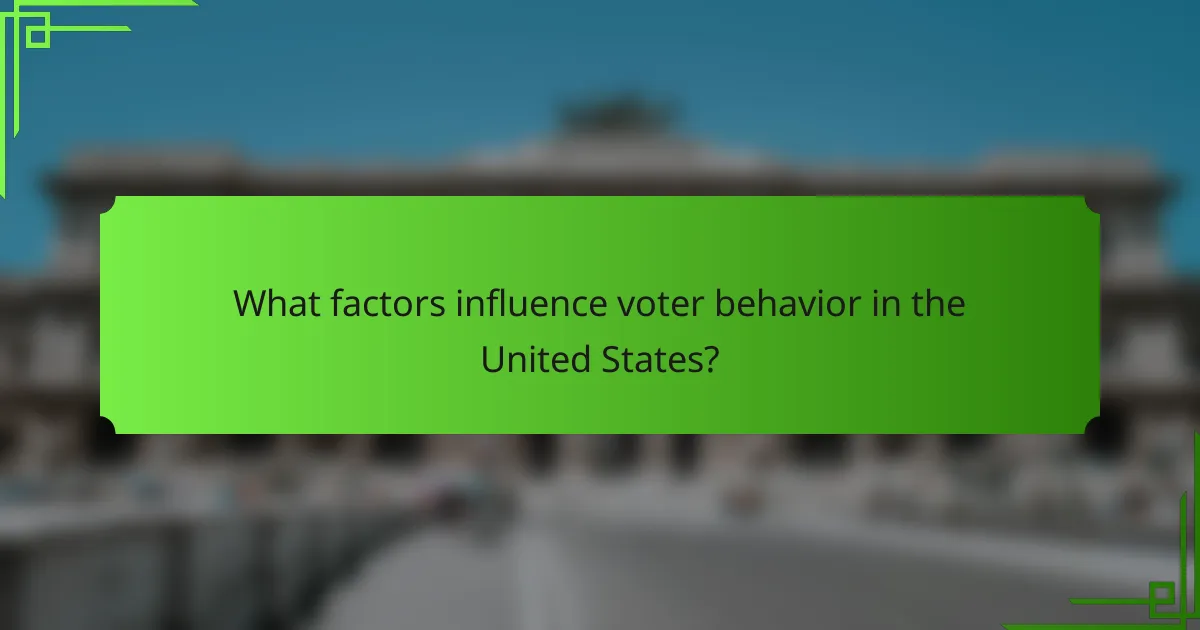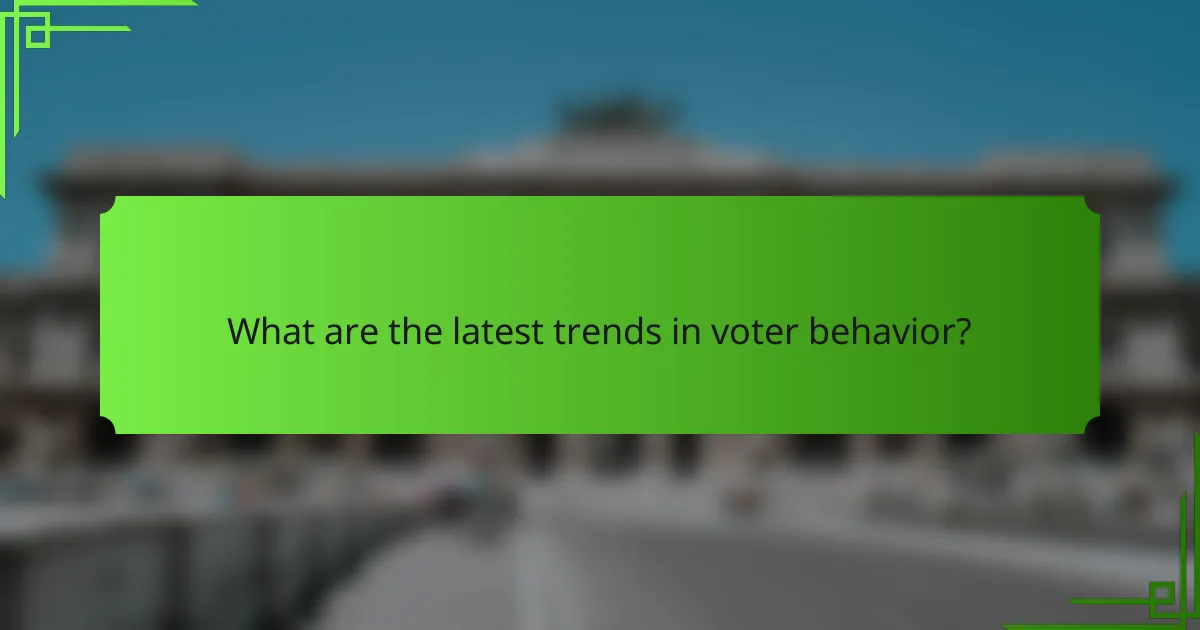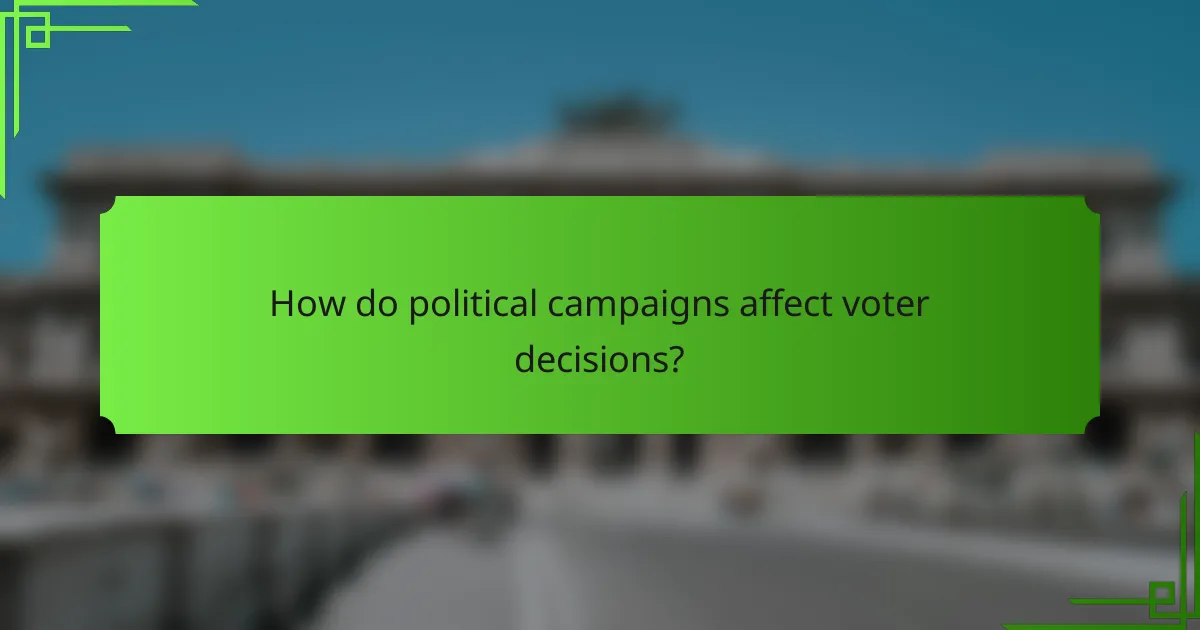Voter behavior in the United States is shaped by a complex interplay of demographics, political beliefs, and local issues, making it essential to analyze these factors for predicting electoral outcomes. Recent trends reveal a notable increase in voter engagement, largely fueled by technological advancements and shifts in demographic patterns, with social media and mail-in voting playing pivotal roles in shaping participation. Understanding these dynamics is crucial for grasping how different groups approach the electoral process and what issues resonate with them.

What factors influence voter behavior in the United States?
Voter behavior in the United States is influenced by a combination of demographics, political beliefs, media habits, timing of elections, and local issues. Understanding these factors can help predict how different groups may vote and what issues resonate with them.
Demographics and socio-economic status
Demographics such as age, gender, race, and income level play a significant role in shaping voter behavior. For instance, younger voters tend to lean more towards progressive candidates, while older voters may favor conservative policies.
Socio-economic status also impacts voting patterns; individuals with higher income levels often prioritize economic issues, while those from lower-income backgrounds may focus on social welfare and healthcare. Understanding these dynamics can help campaigns tailor their messages effectively.
Political affiliation and ideology
Political affiliation is a primary determinant of voter behavior, with individuals typically aligning with either the Democratic or Republican parties. This alignment often reflects broader ideological beliefs, such as views on government intervention, social issues, and fiscal policies.
Independent voters, who do not strongly affiliate with either party, can swing elections and are often influenced by specific candidates or pressing issues. Campaigns targeting these voters may need to emphasize bipartisanship and practical solutions.
Media consumption habits
Media consumption significantly affects how voters perceive candidates and issues. Different demographics consume media through various channels, including traditional news outlets, social media, and podcasts.
For example, younger voters are more likely to engage with political content on platforms like Instagram and TikTok, while older voters may prefer television news. Campaigns must adapt their strategies to reach their target audiences effectively through the preferred media channels.
Election cycle timing
The timing of elections can influence voter turnout and behavior. Presidential elections generally see higher participation rates compared to midterm elections, often due to the heightened visibility of candidates and issues.
Moreover, significant events, such as economic crises or social movements, can impact voter sentiment leading up to an election. Campaigns should consider these factors when planning their outreach efforts and messaging strategies.
Local issues and candidates
Local issues often drive voter behavior, as individuals are more likely to engage with topics that directly affect their communities. Issues such as education, public safety, and local infrastructure can significantly influence voting decisions.
The presence of strong local candidates can also sway voters, especially if they have established credibility and a connection with the community. Campaigns should highlight local concerns and candidates’ qualifications to resonate with voters effectively.

How do voter turnout rates vary by region?
Voter turnout rates significantly differ across regions, influenced by factors such as demographics, accessibility, and local regulations. Urban areas generally see higher participation compared to rural regions, where turnout can be notably lower due to various challenges.
Higher turnout in urban areas
Urban areas typically experience higher voter turnout rates, often exceeding 60% in major cities during national elections. This is attributed to greater access to polling places, more robust civic engagement initiatives, and a diverse population that encourages participation.
For example, cities like New York and Los Angeles have implemented outreach programs that target underrepresented communities, helping to boost turnout. Additionally, urban residents may have more resources and information available, facilitating their voting process.
Lower turnout in rural regions
Rural regions often face lower voter turnout, frequently falling below 50%. Factors contributing to this trend include longer travel distances to polling stations, fewer resources for voter education, and a sense of disenfranchisement among residents.
In many rural areas, limited public transportation options can hinder access to polling places, making it difficult for some individuals to vote. Furthermore, the lack of competitive races in these regions can lead to apathy, reducing motivation to participate in elections.
State-specific regulations
State-specific regulations play a crucial role in shaping voter turnout rates. Different states have varying laws regarding voter registration, identification requirements, and mail-in voting options, which can either facilitate or hinder participation.
For instance, states with same-day registration often see higher turnout compared to those that require advance registration. Additionally, states that offer no-excuse absentee voting tend to attract more voters, as this flexibility allows individuals to cast their ballots without needing to be physically present on Election Day.

What are the latest trends in voter behavior?
The latest trends in voter behavior indicate a significant shift towards increased engagement and participation, driven by technology and changing demographics. Social media, mail-in voting, and youth mobilization are key factors influencing how voters interact with the electoral process.
Increased engagement through social media
Social media platforms have become vital tools for political campaigns, allowing candidates to connect with voters directly and share their messages widely. This engagement often translates into higher voter turnout, particularly among younger demographics who are more active online.
Campaigns are leveraging targeted ads and influencer partnerships to reach specific voter segments, making their messaging more effective. For instance, platforms like Facebook and Instagram enable campaigns to tailor content based on user interests and behaviors, enhancing voter connection.
Rise of mail-in and early voting
Mail-in and early voting have gained popularity, providing voters with more flexibility and convenience. Many jurisdictions have expanded access to these options, allowing voters to cast their ballots ahead of Election Day without facing long lines.
This trend has been particularly beneficial during times of crisis, such as the COVID-19 pandemic, where health concerns prompted many to opt for mail-in ballots. As a result, jurisdictions that implemented these measures often saw increased voter participation rates.
Impact of youth voter mobilization
Youth voter mobilization efforts have become increasingly prominent, with organizations focusing on registering and educating young voters. These initiatives often utilize social media campaigns, campus events, and peer-to-peer outreach to encourage participation.
Research shows that when young voters engage in the electoral process, they tend to have a lasting impact on future elections. Mobilization strategies that resonate with younger audiences, such as emphasizing social justice and climate issues, can significantly influence turnout among this demographic.

How do political campaigns affect voter decisions?
Political campaigns significantly shape voter decisions through various strategies that influence perceptions and preferences. Campaigns utilize targeted messaging, endorsements, and public performances to sway undecided voters and reinforce the loyalty of supporters.
Targeted advertising strategies
Targeted advertising strategies focus on delivering tailored messages to specific voter demographics, enhancing the relevance of campaign communications. By analyzing data on voter behavior and preferences, campaigns can create ads that resonate with particular groups, such as age, location, or political affiliation.
For example, a campaign might use social media platforms to reach younger voters with issues like climate change, while traditional media may be more effective for older demographics concerned about healthcare. This approach can lead to higher engagement rates and increased voter turnout.
Influence of endorsements
Endorsements from influential figures or organizations can significantly impact voter perceptions and decisions. When respected leaders or groups publicly support a candidate, it can enhance credibility and attract undecided voters who value those endorsements.
For instance, a prominent local figure endorsing a candidate can sway voters in that community, especially if the endorser has a strong reputation. Campaigns often seek endorsements from various sectors, including celebrities, political leaders, and advocacy groups, to broaden their appeal.
Debate performances
Debate performances play a crucial role in shaping voter opinions, as they provide candidates an opportunity to showcase their policies and respond to opponents. A strong debate performance can boost a candidate’s visibility and support, while a poor showing may lead to a decline in voter confidence.
Voters often assess candidates based on their ability to articulate ideas, handle pressure, and engage with opponents. Notably, memorable moments or gaffes during debates can become focal points in media coverage, further influencing public perception and voter decisions.

What role does misinformation play in voter behavior?
Misinformation significantly influences voter behavior by shaping perceptions and beliefs about candidates and issues. It can distort facts, leading to misguided decisions at the polls and undermining the integrity of the electoral process.
Spread of false narratives
The spread of false narratives often occurs through social media platforms, where misleading information can reach vast audiences quickly. These narratives can be based on fabricated stories or misrepresented facts, creating confusion among voters.
For example, claims about a candidate’s policies may be exaggerated or taken out of context, leading voters to form opinions based on inaccuracies. This can result in polarized views and a lack of informed decision-making.
Impact on trust in the electoral process
Misinformation can erode public trust in the electoral process by fostering skepticism about the legitimacy of elections. When voters encounter conflicting information about voting procedures or election outcomes, they may question the integrity of the system.
As trust diminishes, voter turnout may decline, particularly among those who feel disenfranchised or uncertain about the reliability of the information they receive. This cycle can perpetuate further misinformation, creating a challenging environment for democratic engagement.
